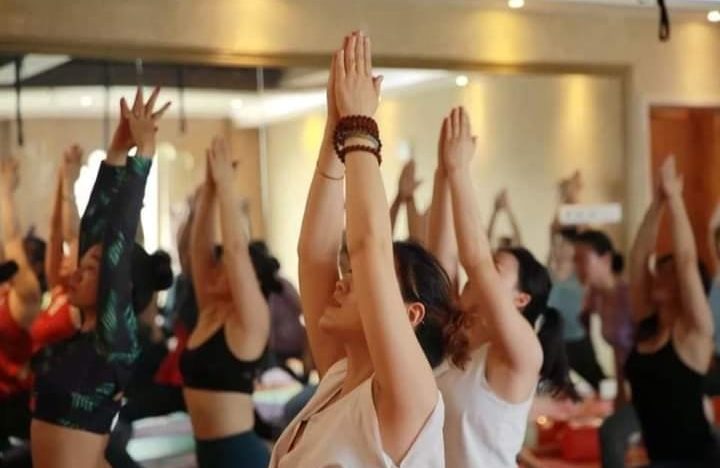In the Ashtanga Yoga tradition, this ancient system finds its origins in the Yoga Korunta, believed to have been imparted by Vamana Rishi. The transmission of this wisdom unfolded through the dedicated lineage of teachers, starting with Sri T. Krishnamacharya, who received the teachings from his Guru, Rama Mohan Brahmachari, in the early 1900s. Subsequently, this profound knowledge was passed on to Pattabhi Jois, who embarked on his transformative journey under Krishnamacharya’s guidance in 1927.
In 1948, Guruji, also known as Sri K. Pattabhi Jois, founded the Ashtanga Yoga Research Institute at their residence in Mysore. This institute has since gained global recognition and is now known as the Shri K. Pattabhi Jois Ashtanga Yoga Institute. Guruji’s pioneering efforts played a pivotal role in popularizing Ashtanga Yoga worldwide, shedding light on its transformative potential as a spiritual path. His teachings continue to enlighten and inspire individuals across the globe, making Ashtanga Yoga a well-known and revered practice.
Presently, His teachings are faithfully perpetuated by his grandson R. Sharath Jois, who directs KPJAYI in Mysore, India and his daughter, Mata’G’ Saraswati Jois.
Key Components of Ashtanga Yoga:
Vinyasa: The essence of Ashtanga Yoga lies in the meticulous synchronization of breath and movement, known as Vinyasa. Each posture is linked to a specific breath, creating a continuous and dynamic flow. This synergy generates internal heat, purifying the body, and enhancing circulation, a crucial aspect of this practice.
Breathing Techniques (Pranayama): Pranayama, or breath control, plays a pivotal role in Ashtanga Yoga. Specific techniques are employed to deepen the practice, focus the mind, and regulate the flow of energy within the body.
Tristhana: Ashtanga Yoga emphasizes the three pillars of attention and action—posture, breath, and the focal point of gaze (Dristhi). Together, these elements purify the body, nervous system, and mind. Postures enhance physical strength and flexibility, while controlled breathing purifies the nervous system. Dristhi stabilizes and purifies the mind.
Bandhas: Mula bandha or root lock at the pelvic floor (drawing in the perineum), Uddiyana bandha, drawing back the abdomen approximately two inches below the navel, Jalandhara bandha, throat lock (achieved by lowering the chin slightly while raising the sternum).
The Six Poisons: As part of internal purification, Ashtanga Yoga addresses the six poisons that obscure the spiritual heart—kama (desire), krodha (anger), moha (delusion), lobha (greed), matsarya (envy), and mada (sloth). Over time, consistent and dedicated practice burns away these impurities, unveiling the inner light of our true nature.
This comprehensive approach embodies the practical and philosophical foundation of Ashtanga Yoga, as handed down through the lineage of Sri K. Pattabhi Jois. To embark on this transformative journey, it is essential to study under a teacher who upholds the parampara/lineage of Sri K. Pattabhi Jois, ensuring a safe and steady progression for both body and mind.
The Guru Shishya Parampara, an ancient Indian tradition, embodies the sacred relationship between a guru (teacher) and shishya (student). This time-honored system is steeped in spiritual and cultural significance, transcending generations to pass down wisdom, knowledge, and values.
At its core, the Guru Shishya Parampara emphasizes the personal and direct transmission of knowledge from guru to shishya. The guru, often considered a spiritual guide or mentor, imparts not just academic or practical wisdom but also deeper insights into life, spirituality, and self-realization. This mentorship extends beyond the boundaries of traditional education, nurturing a profound bond based on trust, respect, and devotion.
The journey of a shishya under the tutelage of a guru is a transformative one. It involves not only the acquisition of knowledge but also the cultivation of character, discipline, and spiritual growth. This transmission of knowledge and values is not confined to textbooks or classrooms; instead, it unfolds through close personal interaction, storytelling, and experiential learning.
The Guru Shishya Parampara is not limited by time or place. It thrives in various fields, including music, art, dance, yoga, philosophy, and spirituality. These relationships often span many years, with the guru guiding the shishya through challenges, obstacles, and moments of enlightenment.
In today’s fast-paced world, where information is readily available, the essence of the Guru Shishya Parampara remains a beacon of wisdom. It serves as a reminder of the profound impact that a dedicated teacher-student relationship can have on one’s personal and spiritual growth, echoing the timeless adage, “When the student is ready, the teacher will appear.”
Ashtanga yoga is often seen as a practice reserved for experienced yogis, potentially intimidating for newcomers. However, at Purple Valley, we embrace beginners wholeheartedly. In our Mysore style classes, you’ll find the perfect blend of group support and personalized attention.
Here, you’re encouraged to progress at your own pace, with teachers readily available to assist in modifying postures to suit your individual needs, whether it’s your first yoga experience or you’re adapting to your unique age, body type, or fitness level. It’s an ideal starting point for novice yogis.
Furthermore, Ashtanga yoga offers a wonderful introduction to the meditative aspects of the practice. It guides you to maintain unwavering focus on your breath, posture, and gaze, anchoring you firmly in the present moment. With a predetermined series, you can immerse yourself in a moving meditation, free from the mental effort of choosing asanas daily.

Copyright @2024, All Rights Reserved. Design By Technomantra India